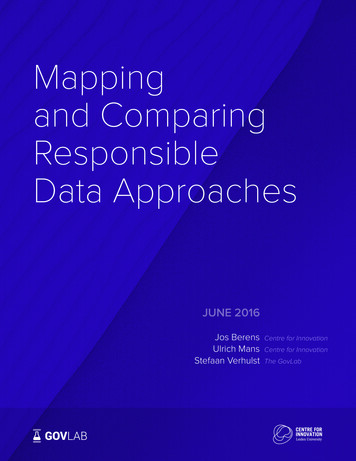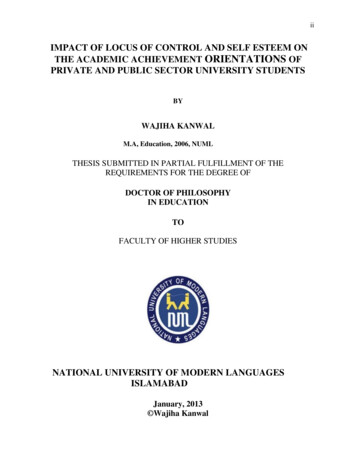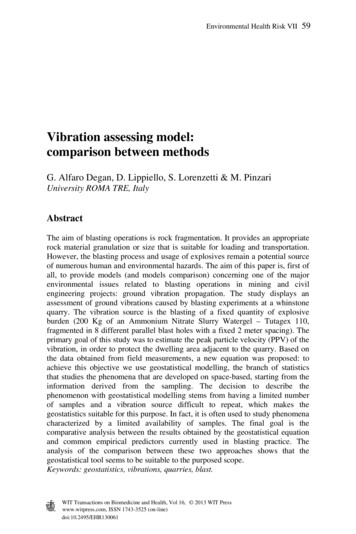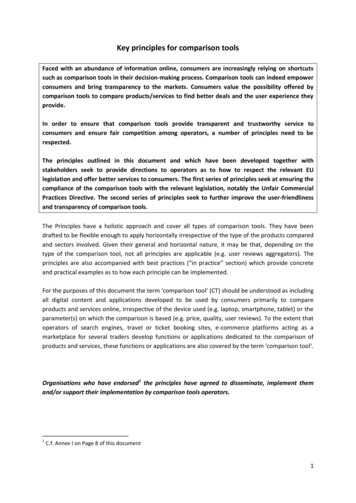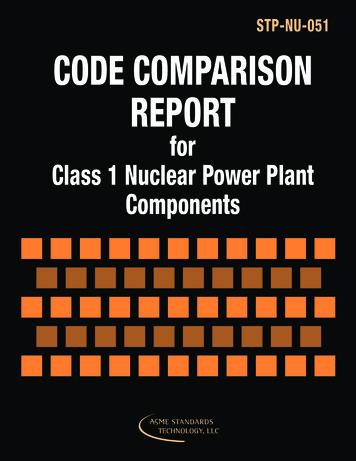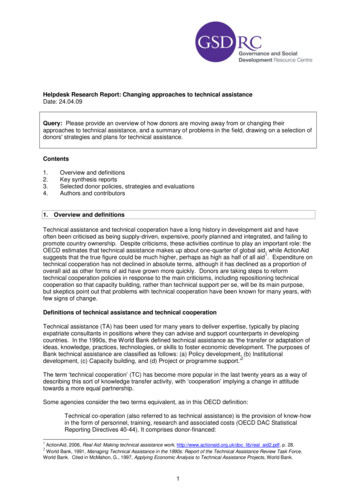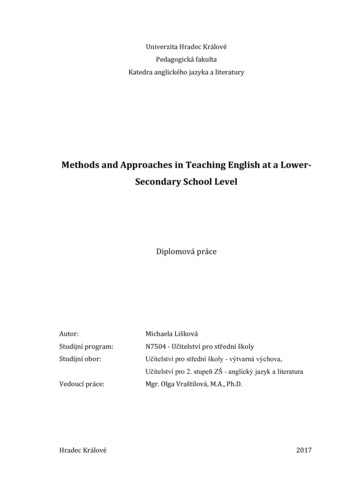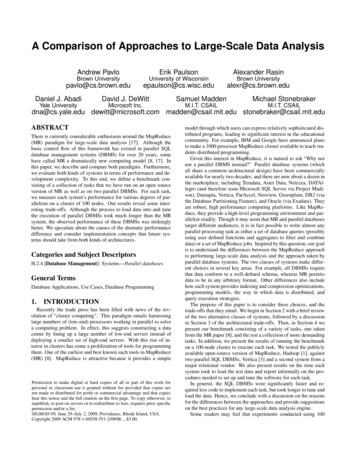
Transcription
A Comparison of Approaches to Large-Scale Data AnalysisAndrew PavloErik PaulsonBrown UniversityUniversity of WisconsinAlexander RasinBrown exr@cs.brown.eduDaniel J. AbadiDavid J. DeWittSamuel MaddenMichael StonebrakerYale UniversityMicrosoft Inc.M.I.T. CSAILM.I.T. CSAILdna@cs.yale.edu dewitt@microsoft.com madden@csail.mit.edu stonebraker@csail.mit.eduABSTRACTThere is currently considerable enthusiasm around the MapReduce(MR) paradigm for large-scale data analysis [17]. Although thebasic control flow of this framework has existed in parallel SQLdatabase management systems (DBMS) for over 20 years, somehave called MR a dramatically new computing model [8, 17]. Inthis paper, we describe and compare both paradigms. Furthermore,we evaluate both kinds of systems in terms of performance and development complexity. To this end, we define a benchmark consisting of a collection of tasks that we have run on an open sourceversion of MR as well as on two parallel DBMSs. For each task,we measure each system’s performance for various degrees of parallelism on a cluster of 100 nodes. Our results reveal some interesting trade-offs. Although the process to load data into and tunethe execution of parallel DBMSs took much longer than the MRsystem, the observed performance of these DBMSs was strikinglybetter. We speculate about the causes of the dramatic performancedifference and consider implementation concepts that future systems should take from both kinds of architectures.Categories and Subject DescriptorsH.2.4 [Database Management]: Systems—Parallel databasesGeneral TermsDatabase Applications, Use Cases, Database Programming1.INTRODUCTIONRecently the trade press has been filled with news of the revolution of “cluster computing”. This paradigm entails harnessinglarge numbers of (low-end) processors working in parallel to solvea computing problem. In effect, this suggests constructing a datacenter by lining up a large number of low-end servers instead ofdeploying a smaller set of high-end servers. With this rise of interest in clusters has come a proliferation of tools for programmingthem. One of the earliest and best known such tools in MapReduce(MR) [8]. MapReduce is attractive because it provides a simplePermission to make digital or hard copies of all or part of this work forpersonal or classroom use is granted without fee provided that copies arenot made or distributed for profit or commercial advantage and that copiesbear this notice and the full citation on the first page. To copy otherwise, torepublish, to post on servers or to redistribute to lists, requires prior specificpermission and/or a fee.SIGMOD’09, June 29–July 2, 2009, Providence, Rhode Island, USA.Copyright 2009 ACM 978-1-60558-551-2/09/06 . 5.00.model through which users can express relatively sophisticated distributed programs, leading to significant interest in the educationalcommunity. For example, IBM and Google have announced plansto make a 1000 processor MapReduce cluster available to teach students distributed programming.Given this interest in MapReduce, it is natural to ask “Why notuse a parallel DBMS instead?” Parallel database systems (whichall share a common architectural design) have been commerciallyavailable for nearly two decades, and there are now about a dozen inthe marketplace, including Teradata, Aster Data, Netezza, DATAllegro (and therefore soon Microsoft SQL Server via Project Madison), Dataupia, Vertica, ParAccel, Neoview, Greenplum, DB2 (viathe Database Partitioning Feature), and Oracle (via Exadata). Theyare robust, high performance computing platforms. Like MapReduce, they provide a high-level programming environment and parallelize readily. Though it may seem that MR and parallel databasestarget different audiences, it is in fact possible to write almost anyparallel processing task as either a set of database queries (possiblyusing user defined functions and aggregates to filter and combinedata) or a set of MapReduce jobs. Inspired by this question, our goalis to understand the differences between the MapReduce approachto performing large-scale data analysis and the approach taken byparallel database systems. The two classes of systems make different choices in several key areas. For example, all DBMSs requirethat data conform to a well-defined schema, whereas MR permitsdata to be in any arbitrary format. Other differences also includehow each system provides indexing and compression optimizations,programming models, the way in which data is distributed, andquery execution strategies.The purpose of this paper is to consider these choices, and thetrade-offs that they entail. We begin in Section 2 with a brief reviewof the two alternative classes of systems, followed by a discussionin Section 3 of the architectural trade-offs. Then, in Section 4 wepresent our benchmark consisting of a variety of tasks, one takenfrom the MR paper [8], and the rest a collection of more demandingtasks. In addition, we present the results of running the benchmarkon a 100-node cluster to execute each task. We tested the publiclyavailable open-source version of MapReduce, Hadoop [1], againsttwo parallel SQL DBMSs, Vertica [3] and a second system from amajor relational vendor. We also present results on the time eachsystem took to load the test data and report informally on the procedures needed to set up and tune the software for each task.In general, the SQL DBMSs were significantly faster and required less code to implement each task, but took longer to tune andload the data. Hence, we conclude with a discussion on the reasonsfor the differences between the approaches and provide suggestionson the best practices for any large-scale data analysis engine.Some readers may feel that experiments conducted using 100
nodes are not interesting or representative of real world data processing systems. We disagree with this conjecture on two points.First, as we demonstrate in Section 4, at 100 nodes the two parallelDBMSs range from a factor of 3.1 to 6.5 faster than MapReduceon a variety of analytic tasks. While MR may indeed be capableof scaling up to 1000s of nodes, the superior efficiency of modern DBMSs alleviates the need to use such massive hardware ondatasets in the range of 1–2PB (1000 nodes with 2TB of disk/nodehas a total disk capacity of 2PB). For example, eBay’s Teradata configuration uses just 72 nodes (two quad-core CPUs, 32GB RAM,104 300GB disks per node) to manage approximately 2.4PB of relational data. As another example, Fox Interactive Media’s warehouse is implemented using a 40-node Greenplum DBMS. Eachnode is a Sun X4500 machine with two dual-core CPUs, 48 500GBdisks, and 16 GB RAM (1PB total disk space) [7]. Since few datasets in the world even approach a petabyte in size, it is not at allclear how many MR users really need 1,000 nodes.2.TWO APPROACHES TO LARGE SCALEDATA ANALYSISThe two classes of systems we consider in this paper run on a“shared nothing” collection of computers [19]. That is, the system is deployed on a collection of independent machines, each withlocal disk and local main memory, connected together on a highspeed local area network. Both systems achieve parallelism bydividing any data set to be utilized into partitions, which are allocated to different nodes to facilitate parallel processing. In thissection, we provide an overview of how both the MR model andtraditional parallel DBMSs operate in this environment.2.1 MapReduceOne of the attractive qualities about the MapReduce programming model is its simplicity: an MR program consists only of twofunctions, called Map and Reduce, that are written by a user toprocess key/value data pairs. The input data set is stored in a collection of partitions in a distributed file system deployed on eachnode in the cluster. The program is then injected into a distributedprocessing framework and executed in a manner to be described.The Map function reads a set of “records” from an input file,does any desired filtering and/or transformations, and then outputsa set of intermediate records in the form of new key/value pairs. Asthe Map function produces these output records, a “split” functionpartitions the records into R disjoint buckets by applying a functionto the key of each output record. This split function is typically ahash function, though any deterministic function will suffice. Eachmap bucket is written to the processing node’s local disk. The Mapfunction terminates having produced R output files, one for eachbucket. In general, there are multiple instances of the Map functionrunning on different nodes of a compute cluster. We use the terminstance to mean a unique running invocation of either the Map orReduce function. Each Map instance is assigned a distinct portionof the input file by the MR scheduler to process. If there are Msuch distinct portions of the input file, then there are R files on diskstorage for each of the M Map tasks, for a total of M R files;Fij , 1 i M, 1 j R. The key observation is that all Mapinstances use the same hash function; thus, all output records withthe same hash value are stored in the same output file.The second phase of a MR program executes R instances of theReduce program, where R is typically the number of nodes. Theinput for each Reduce instance Rj consists of the files Fij , 1 i M . These files are transferred over the network from the Mapnodes’ local disks. Note that again all output records from the Mapphase with the same hash value are consumed by the same Reduceinstance, regardless of which Map instance produced the data. EachReduce processes or combines the records assigned to it in someway, and then writes records to an output file (in the distributed filesystem), which forms part of the computation’s final output.The input data set exists as a collection of one or more partitionsin the distributed file system. It is the job of the MR scheduler todecide how many Map instances to run and how to allocate themto available nodes. Likewise, the scheduler must also decide onthe number and location of nodes running Reduce instances. TheMR central controller is responsible for coordinating the systemactivities on each node. A MR program finishes execution once thefinal result is written as new files in the distributed file system.2.2 Parallel DBMSsDatabase systems capable of running on clusters of shared nothing nodes have existed since the late 1980s. These systems all support standard relational tables and SQL, and thus the fact that thedata is stored on multiple machines is transparent to the end-user.Many of these systems build on the pioneering research from theGamma [10] and Grace [11] parallel DBMS projects. The two keyaspects that enable parallel execution are that (1) most (or even all)tables are partitioned over the nodes in a cluster and that (2) the system uses an optimizer that translates SQL commands into a queryplan whose execution is divided amongst multiple nodes. Becauseprogrammers only need to specify their goal in a high level language, they are not burdened by the underlying storage details, suchas indexing options and join strategies.Consider a SQL command to filter the records in a table T1 basedon a predicate, along with a join to a second table T2 with an aggregate computed on the result of the join. A basic sketch of how thiscommand is processed in a parallel DBMS consists of three phases.Since the database will have already stored T1 on some collectionof the nodes partitioned on some attribute, the filter sub-query isfirst performed in parallel at these sites similar to the filtering performed in a Map function. Following this step, one of two commonparallel join algorithms are employed based on the size of data tables. For example, if the number of records in T2 is small, then theDBMS could replicate it on all nodes when the data is first loaded.This allows the join to execute in parallel at all nodes. Followingthis, each node then computes the aggregate using its portion of theanswer to the join. A final “roll-up” step is required to compute thefinal answer from these partial aggregates [9].If the size of the data in T2 is large, then T2 ’s contents will bedistributed across multiple nodes. If these tables are partitioned ondifferent attributes than those used in the join, the system will haveto hash both T2 and the filtered version of T1 on the join attribute using a common hash function. The redistribution of both T2 and thefiltered version of T1 to the nodes is similar to the processing thatoccurs between the Map and the Reduce functions. Once each nodehas the necessary data, it then performs a hash join and calculatesthe preliminary aggregate function. Again, a roll-up computationmust be performed as a last step to produce the final answer.At first glance, these two approaches to data analysis and processing have many common elements; however, there are notabledifferences that we consider in the next section.3. ARCHITECTURAL ELEMENTSIn this section, we consider aspects of the two system architectures that are necessary for processing large amounts of data in adistributed environment. One theme in our discussion is that the nature of the MR model is well suited for development environmentswith a small number of programmers and a limited application domain. This lack of constraints, however, may not be appropriate forlonger-term and larger-sized projects.
3.1 Schema SupportParallel DBMSs require data to fit into the relational paradigmof rows and columns. In contrast, the MR model does not requirethat data files adhere to a schema defined using the relational datamodel. That is, the MR programmer is free to structure their data inany manner or even to have no structure at all.One might think that the absence of a rigid schema automatically makes MR the preferable option. For example, SQL is oftencriticized for its requirement that the programmer must specify the“shape” of the data in a data definition facility. On the other hand,the MR programmer must often write a custom parser in order toderive the appropriate semantics for their input records, which is atleast an equivalent amount of work. But there are also other potential problems with not using a schema for large data sets.Whatever structure exists in MR input files must be built intothe Map and Reduce programs. Existing MR implementations provide built-in functionality to handle simple key/value pair formats,but the programmer must explicitly write support for more complex data structures, such as compound keys. This is possibly anacceptable approach if a MR data set is not accessed by multipleapplications. If such data sharing exists, however, a second programmer must decipher the code written by the first programmer todecide how to process the input file. A better approach, followedby all SQL DBMSs, is to separate the schema from the applicationand store it in a set of system catalogs that can be queried.But even if the schema is separated from the application andmade available to multiple MR programs through a description facility, the developers must also agree on a single schema. This obviously requires some commitment to a data model or models, andthe input files must obey this commitment as it is cumbersome tomodify data attributes once the files are created.Once the programmers agree on the structure of data, somethingor someone must ensure that any data added or modified does notviolate integrity or other high-level constraints (e.g., employee salariesmust be non negative). Such conditions must be known and explicitly adhered to by all programmers modifying a particular data set;a MR framework and its underlying distributed storage system hasno knowledge of these rules, and thus allows input data to be easilycorrupted with bad data. By again separating such constraints fromthe application and enforcing them automatically by the run timesystem, as is done by all SQL DBMSs, the integrity of the data isenforced without additional work on the programmer’s behalf.In summary, when no sharing is anticipated, the MR paradigm isquite flexible. If sharing is needed, however, then we argue that it isadvantageous for the programmer to use a data description languageand factor schema definitions and integrity constraints out of application programs. This information should be installed in commonsystem catalogs accessible to the appropriate users and applications.3.2 IndexingAll modern DBMSs use hash or B-tree indexes to accelerate access to data. If one is looking for a subset of records (e.g., employees with a salary greater than 100,000), then using a properindex reduces the scope of the search dramatically. Most databasesystems also support multiple indexes per table. Thus, the queryoptimizer can decide which index to use for each query or whetherto simply perform a brute-force sequential search.Because the MR model is so simple, MR frameworks do not provide built-in indexes. The programmer must implement any indexesthat they may desire to speed up access to the data inside of theirapplication. This is not easily accomplished, as the framework’sdata fetching mechanisms must also be instrumented to use theseindexes when pushing data to running Map instances. Once more,this is an acceptable strategy if the indexes do not need to be sharedbetween multiple programmers, despite requiring every MR programmer re-implement the same basic functionality.If sharing is needed, however, then the specifications of what indexes are present and how to use them must be transferred betweenprogrammers. It is again preferable to store this index informationin a standard format in the system catalogs, so that programmerscan query this structure to discover such knowledge.3.3 Programming ModelDuring the 1970s, the database research community engaged in acontentious debate between the relational advocates and the Codasyl advocates [18]. The salient issue of this discussion was whethera program to access data in a DBMS should be written either by:1. Stating what you want – rather than presenting an algorithmfor how to get it (Relational)2. Presenting an algorithm for data access (Codasyl)In the end, the former view prevailed and the last 30 years isa testament to the value of relational database systems. Programsin high-level languages, such as SQL, are easier to write, easierto modify, and easier for a new person to understand. Codasylwas criticized for being “the assembly language of DBMS access”.We argue that MR programming is somewhat analogous to Codasylprogramming: one is forced to write algorithms in a low-level language in order to perform record-level manipulation. On the otherhand, to many people brought up programming in procedural languages, such as C/C or Java, describing tasks in a declarativelanguage like SQL can be challenging.Anecdotal evidence from the MR community suggests that thereis widespread sharing of MR code fragments to do common tasks,such as joining data sets. To alleviate the burden of having to reimplement repetitive tasks, the MR community is migrating highlevel languages on top of the current interface to move such functionality into the run time. Pig [15] and Hive [2] are two notableprojects in this direction.3.4 Data DistributionThe conventional wisdom for large-scale databases is to alwayssend the computation to the data, rather than the other way around.In other words, one should send a small program over the networkto a node, rather than importing a large amount of data from thenode. Parallel DBMSs use knowledge of data distribution and location to their advantage: a parallel query optimizer strives to balancecomputational workloads while minimizing the amount data transmitted over the network connecting the nodes of the cluster.Aside from the initial decision on where to schedule Map instances, a MR programmer must perform these tasks manually. Forexample, suppose a user writes a MR program to process a collection of documents in two parts. First, the Map function scans thedocuments and creates a histogram of frequently occurring words.The documents are then passed to a Reduce function that groupsfiles by their site of origin. Using this data, the user, or anotheruser building on the first user’s work, now wants to find sites witha document that contains more than five occurrences of the word‘Google’ or the word ‘IBM’. In the naive implementation of thisquery, where the Map is executed over the accumulated statistics,the filtration is done after the statistics for all documents are computed and shipped to reduce workers, even though only a small subset of documents satisfy the keyword filter.In contrast, the following SQL view and select queries perform asimilar computation:
CREATESELECTFROMGROUPSELECTFROMWHEREVIEW Keywords ASsiteid, docid, word, COUNT(*) AS wordcountDocumentsBY siteid, docid, word;DISTINCT siteidKeywords(word ‘IBM’ OR word ‘Google’) AND wordcount 5;A modern DBMS would rewrite the second query such that theview definition is substituted for the Keywords table in the FROMclause. Then, the optimizer can push the WHERE clause in the querydown so that it is applied to the Documents table before the COUNTis computed, substantially reducing computation. If the documentsare spread across multiple nodes, then this filter can be applied oneach node before documents belonging to the same site are groupedtogether, generating much less network I/O.3.5 Execution StrategyThere is a potentially serious performance problem related toMR’s handling of data transfer between Map and Reduce jobs. Recall that each of the N Map instances produces M output files,each destined for a different Reduce instance. These files are written to the local disk on the node executing each particular Map instance. If N is 1000 and M is 500, the Map phase of the programproduces 500,000 local files. When the Reduce phase starts, eachof the 500 Reduce instances needs to read its 1000 input files andmust use a file-transfer protocol to “pull” each of its input files fromthe nodes on which the Map instances were run. With 100s of Reduce instances running simultaneously, it is inevitable that two ormore Reduce instances will attempt to read their input files fromthe same map node simultaneously, inducing large numbers of diskseeks and slowing the effective disk transfer rate. This is why parallel database systems do not materialize their split files and insteaduse a push approach to transfer data instead of a pull.3.6 FlexibilityDespite its widespread adoption, SQL is routinely criticized forits insufficient expressive prowess. Some believe that it was a mistake for the database research community in the 1970s to focus ondata sub-languages that could be embedded in any programminglanguage, rather than adding high-level data access to all programming languages. Fortunately, new application frameworks, such asRuby on Rails [21] and LINQ [14], have started to reverse this situation by leveraging new programming language functionality toimplement an object-relational mapping pattern. These programming environments allow developers to benefit from the robustnessof DBMS technologies without the burden of writing complex SQL.Proponents of the MR model argue that SQL does not facilitatethe desired generality that MR provides. But almost all of the majorDBMS products (commercial and open-source) now provide support for user-defined functions, stored procedures, and user-definedaggregates in SQL. Although this does not have the full generalityof MR, it does improve the flexibility of database systems.3.7 Fault ToleranceThe MR frameworks provide a more sophisticated failure modelthan parallel DBMSs. While both classes of systems use some formof replication to deal with disk failures, MR is far more adept athandling node failures during the execution of a MR computation.In a MR system, if a unit of work (i.e., processing a block of data)fails, then the MR scheduler can automatically restart the task onan alternate node. Part of the flexibility is the result of the fact thatthe output files of the Map phase are materialized locally instead ofbeing streamed to the nodes running the Reduce tasks. Similarly,pipelines of MR jobs, such as the one described in Section 4.3.4,materialize intermediate results to files each step of the way. Thisdiffers from parallel DBMSs, which have larger granules of work(i.e., transactions) that are restarted in the event of a failure. Part ofthe reason for this approach is that DBMSs avoid saving intermediate results to disk whenever possible. Thus, if a single node failsduring a long running query in a DBMS, the entire query must becompletely restarted.4. PERFORMANCE BENCHMARKSIn this section, we present our benchmark consisting of five tasksthat we use to compare the performance of the MR model with thatof parallel DBMSs. The first task is taken directly from the original MapReduce paper [8] that the authors’ claim is representative ofcommon MR tasks. Because this task is quite simple, we also developed four additional tasks, comprised of more complex analyticalworkloads designed to explore the trade-offs discussed in the previous section. We executed our benchmarks on a well-known MRimplementation and two parallel DBMSs.4.1 Benchmark EnvironmentAs we describe the details of our benchmark environment, wenote how the different data analysis systems that we test differ inoperating assumptions and discuss the ways in which we dealt withthem in order to make the experiments uniform.4.1.1 Tested SystemsHadoop: The Hadoop system is the most popular open-source implementation of the MapReduce framework, under developmentby Yahoo! and the Apache Software Foundation [1]. Unlike theGoogle implementation of the original MR framework written inC , the core Hadoop system is written entirely in Java. For ourexperiments in this paper, we use Hadoop version 0.19.0 runningon Java 1.6.0. We deployed the system with the default configuration settings, except for the following changes that we found yieldedbetter performance without diverging from core MR fundamentals:(1) data is stored using 256MB data blocks instead of the default64MB, (2) each task executor JVM ran with a maximum heap sizeof 512MB and the DataNode/JobTracker JVMs ran with a maximum heap size of a 1024MB (for a total size of 3.5GB per node),(3) we enabled Hadoop’s “rack awareness” feature for data localityin the cluster, and (4) we allowed Hadoop to reuse the task JVMexecutor instead starting a new process for each Map/Reduce task.Moreover, we configured the system to run two Map instances anda single Reduce instance concurrently on each node.The Hadoop framework also provides an implementation of theGoogle distributed file system [12]. For each benchmark trial, westore all input and output data in the Hadoop distributed file system(HDFS). We used the default settings of HDFS of three replicasper block and without compression; we also tested other configurations, such as using only a single replica per block as well as blockand record-level compression, but we found that our tests almostalways executed at the same speed or worse with these features enabled (see Section 5.1.3). After each benchmark run finishes for aparticular node scaling level, we delete the data directories on eachnode and reformat HDFS so that the next set of input data is replicated uniformly across all nodes.Hadoop uses a central job tracker and a “master” HDFS daemonto coordinate node activities. To ensure that these daemons do notaffect the performance of worker nodes, we execute both of theseadditional framework components on a separate node in the cluster.DBMS-X: We used the latest release of DBMS-X, a parallel SQLDBMS from a major relational database vendor that stores data in
a row-based format. The system is installed on each node and configured to use 4GB shared memory segments for the buffer pooland other temporary space. Each table is hash partitioned acrossall nodes on the salient attribute for that particular table, and thensorted and indexed on different attributes (see Sections 4.2.1 and4.3.1). Like the Hadoop experiments, we deleted the tables in DBMSX and reloaded the data for each trial to ensure that the tuples wasuniformly distributed in the cluster.By default DBMS-X does not compress data in its internal storage, but it does provide ability to compress tables using a wellknown dictionary-based scheme. We found that enabling compression reduced the execution times for almost all the benchmark tasksby 50%, and thus we only report results with compression enabled.In only one case did we find that using compression actually performed worse. Furthermore, because all of our benchmarks areread-only, we did not enable replication features in DBMS-X, sincethis would not have improved performance and complicates the installation process.Vertica: The Vertica database is a parallel DBMS designed forlarge data warehouses [3]. The main distinction of Vertica fromother DBMSs (including DBMS-X) is that all data is stored as columns,rather than rows [20]. It uses a unique execution engine designedspecifically for operating on top of a column-oriented storage layer.Unlike DBMS-X, Vertica compresses data by default since its executor can operate directly on compressed tables. Because disabling this feature is not typical in Vertica deployments, the Vertica results in this paper are generated using only compressed data.Vertica also sorts every table by one or more attributes based on aclustered index.We found that the default 256MB buffer size per node performedwell in our experiments. The Vertica resource manager is responsible for setting the amount of memory given to queries, but weprovide a hint to the system to expect to execute only one query ata time. Thus, each query receives most the maximum amount ofmemory available on each node at runtime
Yale University Microsoft Inc. M.I.T. CSAIL M.I.T. CSAIL dna@cs.yale.edu dewitt@microsoft.com madden@csail.mit.edu stonebraker@csail.mit.edu ABSTRACT There is currently considerable enthusiasm around the MapReduce (MR) paradigm for large-scale data analysis [17]. Althoughthe basic control flow of this framework has existed in parallel S QL


